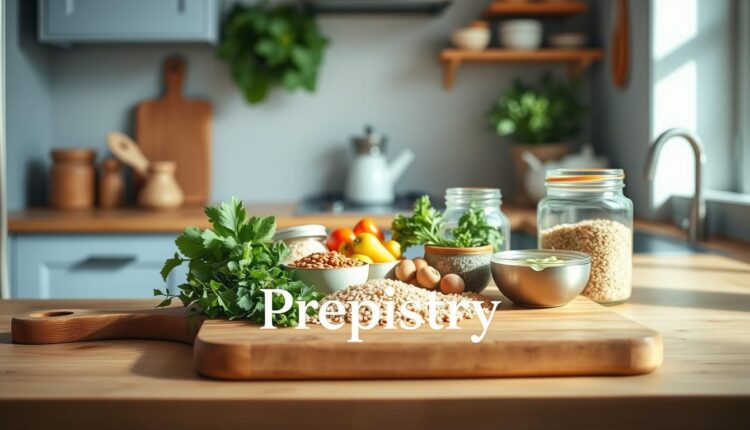Lunch Meal Prep Seasonal Menu Quarterly Planning
Simplify your lunches with our lunch meal prep seasonal menu quarterly planning guide. Get practical tips and meal ideas.
What if three hours today could save you fifteen next week? Most home cooks spend 45 minutes daily deciding what to make – time that adds up faster than chopped onions. This kitchen-tested approach flips the script by aligning your prep calendar with nature’s freshest flavors.
Quarterly planning turns chaotic weeknights into smooth routines. Think of it as building a flavor roadmap: fresh ingredients at their peak become building blocks for dishes that feel special without extra effort. I’ve seen freezer-friendly strategies transform rushed evenings into relaxed family time – even with picky eaters at the table.
- Map three months of ideas using produce trends
- Batch-prep components that work across recipes
- Create adaptable systems vs rigid schedules
This isn’t about Pinterest-perfect containers. It’s real-life solutions for when work runs late or kids request tacos…again. Let’s craft your blueprint for nourishing eats that actually get eaten.
Lunch Meal Prep Seasonal Menu Quarterly Planning
Imagine cutting your kitchen time in half while enjoying fresher flavors. Quarterly planning organizes your cooking around three-month cycles, turning chaotic weeks into streamlined routines. This method helps you save money by buying ingredients when they’re abundant and affordable.
Think of it as building a flexible blueprint. You’ll focus on versatile components like roasted vegetables or grilled chicken that work in multiple dishes. A batch of citrus-marinated poultry becomes tacos today and a salad topping tomorrow.
Overview of Quarterly Meal Planning
This approach prioritizes ingredients at their peak. Summer might feature berry-packed salads, while fall leans into roasted squash bowls. You’ll reduce food waste by using what’s readily available at markets.
Balancing nutrition becomes effortless when your rotation includes colorful produce and lean proteins. Try pairing crisp apples with baked chicken for autumn lunches, or mix grilled zucchini into grain bowls during warmer months. The key is creating adaptable foundations that keep your taste buds engaged.
Time management gets simpler too. Spend one Sunday prepping base ingredients, then assemble meals quickly throughout the week. You’ll dodge the 5 PM “what’s for dinner?” panic while maintaining variety in your routine.
Why Seasonal Eating is Key to Successful Meal Prep
Ever bite into a winter tomato that tastes like cardboard? That’s nature’s reminder: timing matters. Fresh-picked ingredients at their peak pack more than flavor—they deliver nutrients your body craves. Let’s explore how aligning your kitchen rhythm with the earth’s calendar creates meals that work smarter, not harder.
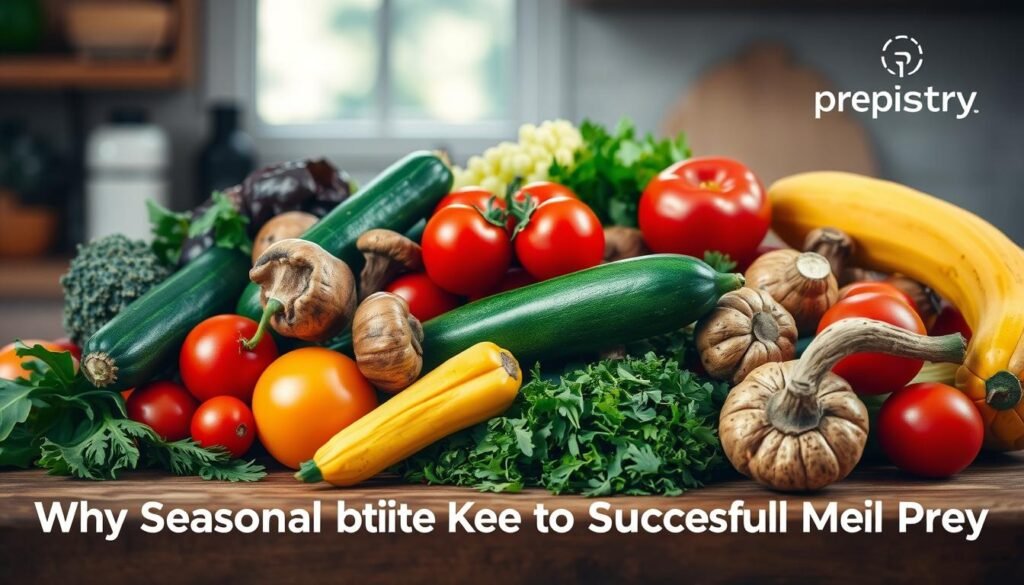
Seasonal Produce Benefits
Locally grown veggies harvested ripe contain up to 40% more vitamins than their shipped counterparts. I learned this firsthand when my summer zucchini noodles stayed crisp three days longer than off-season versions. Bright, just-picked greens need minimal dressing—their natural vibrancy does the heavy lifting.
Nutritional Advantages of Fresh Ingredients
Spinach loses half its folate within seven days of picking. That’s why I plan Thursday meals around Wednesday’s farmers’ market haul. Peak-season produce requires less prep time too—think tender asparagus that snaps cleanly versus woody stalks needing extra trimming.
“Food is most nutritious when consumed closest to its harvest date,” notes agricultural researcher Dr. Ellen Park. Your weekday grain bowls gain antioxidant power simply by using berries picked at their sweetest moment.
Three practical steps to start today:
- Check your state’s seasonal food guide (most have free PDFs)
- Build meals around weekly specials at grocery stores
- Roast extra veggies while prepping—they’ll keep 5 days for quick wraps or scrambles
Your cutting board becomes a nutrient hub when stocked with rainbow-colored finds. Those crisp sugar snap peas? Toss them in salads raw for maximum crunch and vitamin C retention. Time saved on seasoning compensates for busy schedules.
Planning Your Quarterly Meal Prep Strategy
Clear goals transform kitchen chaos into culinary wins. Last summer, I discovered my zucchini bread obsession left zero freezer space for August tomatoes—a lesson in strategic planning. Your quarterly roadmap starts with three questions: What flavors excite you? Which dishes simplify busy days? How can ingredients multitask across meals?
Setting Your Quarterly Goals
Start by reviewing last quarter’s hits and misses. Did basil-heavy recipes wilt before use? Swap them for cherry tomato skewers that freeze beautifully. Summer’s bounty inspires chilled noodle salads with lime dressing—prep dressing once, use all week.
Try this framework:
- Choose 2-3 seasonal stars (think heirloom tomatoes or corn)
- Batch-cook bases like whole-grain noodles or quinoa
- Design 3 adaptable recipes using both
“Goals should stretch your skills but fit your schedule,” I tell clients. A parent might roast six chicken breasts Sunday, then create three meals: shred some for tacos, slice others for sandwiches, dice leftovers for fried rice.
Tomato lovers, rejoice! Blend roasted Romas into a freezer sauce for pizzas or shakshuka. Pair with quick-cooking noodles tossed in pesto for last-minute dinners. Track what works in a notes app—next quarter’s plan will practically write itself.
Optimizing Your lunch meal prep seasonal menu for Every Season
Ever tried reviving limp greens with a zesty dressing? That’s the power of strategic sauces. I once transformed roasted root vegetables into a crowd-pleaser using a ginger-miso glaze—proof that condiments make ordinary ingredients shine.
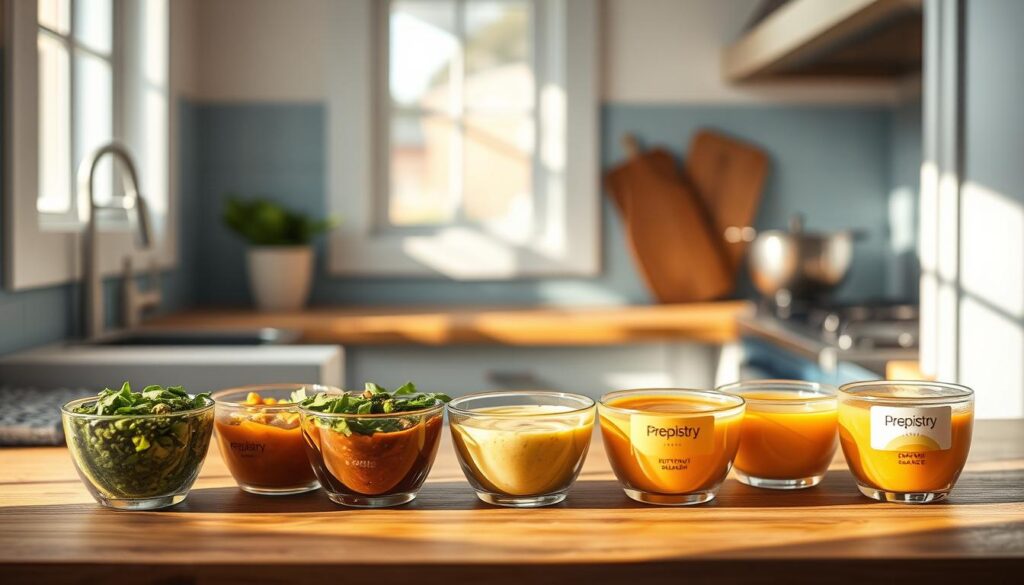
Build a core rotation of three adaptable sauces. A bright lemon-tahini blend lifts spring asparagus, while smoky chipotle mayo adds depth to summer grilled corn. Come fall, blend roasted squash into silky pasta sauce. Winter’s hearty greens pair perfectly with warm balsamic reduction.
Here’s my go-to way to bridge seasons:
- Swap basil pesto for sage-walnut version as temperatures drop
- Thin summer’s chimichurri with yogurt for autumn crudité dips
- Freeze herb-packed oils in ice cubes for off-month flavor boosts
“A great sauce is like a good playlist—it sets the mood for whatever you’re serving,” I remind clients during our kitchen sessions.
Raw vegetables become crave-worthy when dunked in spiced Greek yogurt or almond butter drizzle. Last Tuesday’s sad celery sticks? They vanished once paired with my five-minute tahini-maple dip. Keep dressings bold but balanced—your taste buds will thank you.
Three-sauce rotation strategy:
- 1 creamy base (cashew ranch or avocado lime)
- 1 acid-forward option (citrus vinaigrette or quick-pickled onion brine)
- 1 texture booster (crunchy seed mix or crispy garlic chips)
Harnessing Fresh Ingredients & Seasonal Produce
Have you ever compared a farmers’ market strawberry to its grocery store counterpart? The difference isn’t just taste—it’s about nutrients locked in by shorter travel times. Building meals around hyper-local ingredients creates vibrant plates that nourish body and budget.
Local Sourcing Tips
Your closest food hub holds flavor gold. I train clients to spot “grown within 100 miles” labels at markets. Ask vendors what’s picked that morning—their spinach will outlast shipped greens by days. Three field-tested strategies:
- Arrive early for peak selection (pro tip: bring reusable mesh bags)
- Seek odd-shaped veggies—they’re often priced lower but taste identical
- Download your state’s seasonal food calendar as a lock screen reminder
“We pick leafy greens at dawn for maximum crispness,” shares North Carolina grower Marissa Torres. That freshness translates to salads staying perky through Friday’s lunchbox.
Maximizing Nutrient Intake
Kale’s tough fibers soften when massaged with citrus dressing—a trick that boosts iron absorption. Pair it with roasted chickpeas for crunch and plant-based protein. Morning routines gain power too: blend local berries into overnight oats or fold wilted greens into egg muffins.
Try these combos:
- Drizzle honey-mustard dressing over shredded cabbage for gut-friendly slaw
- Toss breakfast sweet potatoes with cinnamon and almond butter
- Store chopped veggies upright in water jars to preserve crunch
Your cutting board becomes a nutrient hub when stocked with rainbow-colored finds. Time saved on seasoning compensates for busy schedules.
Seasonal Lunch Recipes: A Variety of Options
Ever stared at your fridge wondering how to make the same ingredients exciting again? The solution lies in strategic recipe rotation. I discovered this after my third week of kale salads—even my most devoted green-loving client begged for variety. Let’s explore two crowd-pleasing categories that adapt to any season.
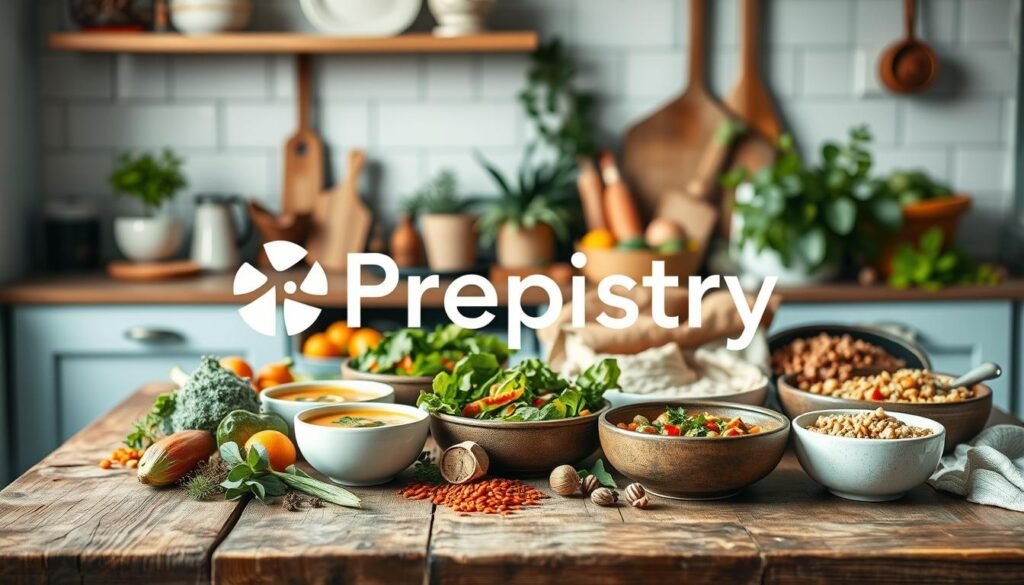
Refreshing Creations & Bowls
Bright flavors needn’t mean complicated steps. My Mediterranean Quinoa Salad combines pre-cooked grains with cherry tomatoes, cucumber, and lemon-herb dressing. For protein, add chickpeas—they’re affordable, shelf-stable, and pack 15g of plant-based protein per cup.
Warm Comfort Dishes
Chickpea-based stews shine when temperatures drop. Try this flexible template:
| Recipe | Base | Protein | Prep Time |
|---|---|---|---|
| Moroccan Spiced Stew | Tomato broth | Chickpeas + chicken | 35 mins |
| Coconut Curry Bowl | Butternut squash | Chickpeas + shrimp | 25 mins |
“Chickpeas are the chameleons of legumes—roast them crispy for texture, blend them into creamy dressings, or simmer them in broths,” I tell clients during pantry makeovers.
Three tips for success:
- Double batch dressings—they’ll transform roasted veggies into new creations
- Freeze stew portions in muffin tins for single-serving reheating
- Mix fresh and frozen produce based on availability
Efficient Meal Prep Techniques for Busy Weekdays
Your freezer holds more potential than you think—let’s unlock its weekday magic. Last month, my neighbor texted me a photo of her mushy reheated casserole with a crying emoji. We transformed her frostbitten disaster into a system that now saves her 90 minutes weekly. Here’s how to make cold storage your ally.
Freezer-Friendly Meal Prep Ideas
Ladling soup into portioned jars changed my winter routine. Broths and stews actually improve when frozen—flavors meld beautifully. Try these strategies:
- Pack spring vegetable soups in single-serve containers for grab-and-go warmth
- Mark bags with cooking dates using painter’s tape (sharpie smudges!)
- Layer grain bowls upside-down: sauce at bottom, proteins in middle, greens on top
Batch cooking shines during seasonal shifts. When asparagus arrives, I roast four sheet pans—half becomes soup starters, the rest goes into frittatas. My slow cooker simmers overnight while I sleep, yielding tender meats for multiple dishes.
“Freezing isn’t about hoarding—it’s creating flavor insurance,” I remind clients. Thawed roasted peppers elevate Tuesday’s omelet, while frozen herb cubes jazz up Thursday’s pasta.
Three rules for success:
- Cool foods completely before freezing to prevent ice crystals
- Leave headspace in containers for expansion
- Group similar items together (all breakfasts on one shelf)
Spring’s delicate greens need special care. Blanch peas before freezing to preserve their sweetness. Portion snap peas into snack bags for crunchy additions to stir-fries. Your future self will thank you when deadlines hit.
Integrating Proteins and Veggies in Your Meal Plan
Have you ever tossed together a last-minute dish only to find it lacking substance? I faced this with a client whose veggie-packed stir-fry left her hungry by 3 PM. We solved it by adding black beans—transforming it into a satisfying powerhouse. Balanced plates need both plant-based proteins and colorful vegetables to keep energy steady.
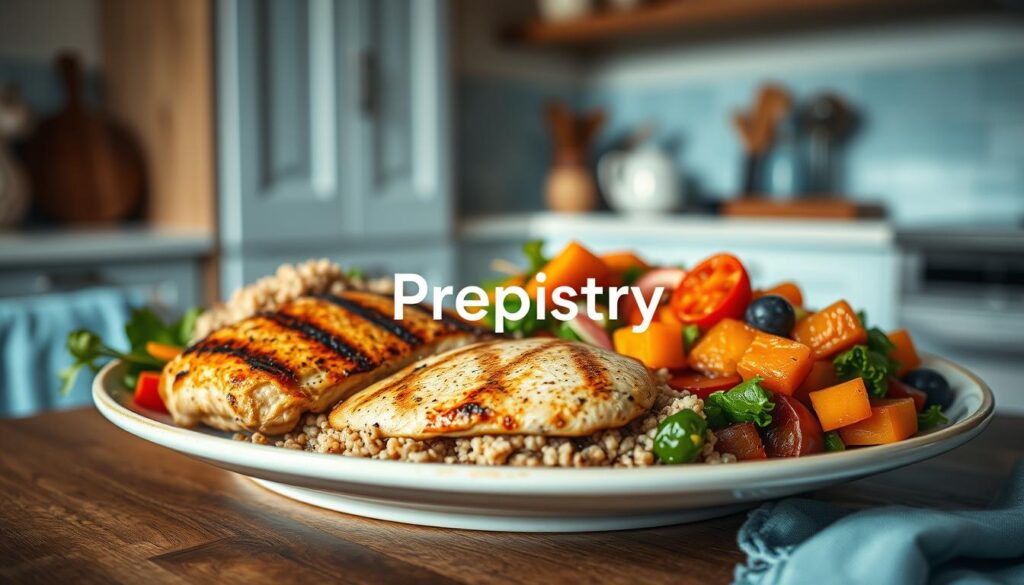
Beans and rice form the ultimate budget-friendly duo. One cup of cooked lentils packs 18g protein, while brown rice adds chewiness that makes dishes feel indulgent. Mix them with roasted corn for natural sweetness and crunch—it’s like nature’s confetti adding joy to every bite.
Versatile Protein Options
My kitchen mantra: “Prep once, eat thrice.” Simmer a big pot of pinto beans on Sunday. Use them in chili, mash for spreads, or toss into salads. Rice freezes beautifully too—portion cooked jasmine rice into muffin tins for quick thawing. Corn shines year-round: char kernels for tacos or blend into chowder bases.
Try these combos:
- Black bean & corn stuffed peppers with cilantro-lime rice
- Chickpea curry over turmeric basmati with roasted veggies
- White bean salad with cherry tomatoes and lemon-parsley quinoa
“Plant proteins build flexible foundations,” says nutritionist Dr. Elena Marcos. “Pair them with different grains and veggies to prevent taste fatigue.”
Keep textures appealing. Roast chickpeas until crispy for salads, or simmer kidney beans into creamy mashes. For balanced plates, aim for 1/4 protein, 1/4 grains, and 1/2 veggies. Your body—and taste buds—will notice the difference.
Crafting Delicious Dressings and Sauces
That bottle of store-bought ranch hiding in your fridge door? Let’s talk about upgrading your flavor game. Dressings act as culinary translators—they turn humble veggies into crave-worthy creations. I once watched a client’s teenager devour two bowls of kale after we whipped up a tangy lemon-tahini drizzle.
Homemade & Healthy Recipes
Start with this formula: 2 parts oil, 1 part acid, plus flavor boosters. My Mediterranean Quinoa Salad’s Italian dressing uses olive oil, red wine vinegar, and oregano. Batch it Sunday—it stays fresh for 10 days in mason jars. Three seasonal twists:
- Spring: Swap vinegar for blood orange juice + fresh thyme
- Summer: Blend basil + garlic into Greek yogurt base
- Fall: Mix pumpkin puree with apple cider vinegar + sage
“Great dressings balance boldness and subtlety,” I tell cooking class students. “They should complement ingredients, not drown them.”
For pasta lovers, try roasted red pepper sauce. Blend charred peppers with walnuts and smoked paprika. Toss with whole-grain noodles—it freezes beautifully for quick dinners. Update your rotation monthly using farmers’ market finds. July’s peaches become ginger-laced vinaigrette, while November’s pears shine in maple-Dijon blends.
Three storage tips:
- Use squeeze bottles for portion control
- Freeze herb-infused oils in ice cube trays
- Label jars with creation dates
Stocking Your Pantry with Essential Staples
Ever opened your cupboard to find nothing but expired spices and half-empty pasta boxes? I faced this exact scenario last month while helping a client revamp their kitchen setup. A well-curated pantry acts like a culinary safety net—it turns “what’s for dinner?” panic into confident decisions.

- Whole grains (quinoa, brown rice)
- Canned legumes (black beans, chickpeas)
- Nuts and seeds for crunch
- Versatile oils and vinegars
- Dried herbs and spices
These basics transform simple ingredients into satisfying bowls. Massaged kale stays crisp for three days when stored in airtight containers with a paper towel. Toss it with pre-cooked grains, roasted veggies, and a squeeze of lemon for a nutrient-packed bowl in 10 minutes.
Rotate items quarterly using printable checklists. Summer might highlight chia seeds for no-cook puddings, while winter calls for hearty lentils. Organized shelves mean less time digging for ingredients—more moments enjoying your creations.
“Your pantry isn’t a storage space—it’s a creativity launchpad,” I remind clients during pantry audits. Keep frequently used items at eye level to streamline cooking sessions.
Three rules for success:
- Label containers with purchase dates
- Store nuts in the freezer to prevent rancidity
- Group similar items (all baking supplies together)
With these strategies, even chaotic weeks become manageable. That forgotten can of white beans? It’s now the star of tomorrow’s garlicky hummus wrap.
Adapting Your Meal Prep to Seasonal Trends
What if your kitchen could dance to nature’s rhythm? I once served the same roasted veggie bowl in January and June—only to realize winter’s squash felt comforting while summer’s version begged for brightness. Aligning your cooking with the earth’s cycles keeps plates exciting without extra effort.
Seasonal Favorites for Spring/Summer
Sun-drenched days call for crisp textures. Whip up a pepper-studded frittata using farm-fresh eggs—it stays moist for three days chilled. Try this twist: layer thinly sliced bell peppers with wilted spinach, then bake with a yogurt-herb batter. Serve cold with a lemon-dill dip for picnic-ready fuel.
Comfort Foods for Fall/Winter
When frost hits, transform those peppers into smoky roasted strips. Simmer them in tomato broth with white beans for a hearty stew. Crack an egg into each serving for silky richness—the steam cooks it perfectly. One client’s family now requests this weekly, swapping beans for lentils when temperatures plummet.
“A great recipe is like a favorite sweater—it should fit every season with minor adjustments,” I tell my cooking class students.
Three ways to pivot dishes:
- Swap raw peppers for roasted versions as days shorten
- Use soft-boiled eggs in summer salads → poached eggs in winter grain bowls
- Turn one base recipe (like quinoa pilaf) into cold salads or warm casseroles
Last March, a client’s spring asparagus pasta morphed into a roasted root veg bake by November. She kept the garlic-lemon sauce but changed the stars—proof that flexibility beats rigid routines.
Time-Saving Tools and Meal Prep Hacks
Your knife skills shouldn’t determine your dinner success. After helping a client salvage a butchered avocado with my favorite $15 gadget, I realized smart tools matter more than perfection. Let’s explore kitchen allies that turn rushed evenings into efficient cooking sessions.

Quick Prep Techniques
A sharp chef’s knife cuts avocado prep time in half—slice through pits cleanly with a gentle twist. Pair it with rubber-edged containers that lock in freshness for 5 days. Three game-changers:
- Use a mandoline for uniform pumpkin slices that roast evenly
- Freeze stew bases in silicone molds for single-serve portions
- Keep pre-washed greens in glass jars with damp towels
Batch-cook stews smarter: brown meats while roasting veggies. Combine everything in a pressure cooker—flavors deepen while you tackle other tasks. Pureed pumpkin becomes instant soup when whisked into broth with ginger and coconut milk.
“The right tool isn’t about price tags—it’s what gets used weekly,” I remind clients during kitchen audits. That avocado saver? It’s rescued 37 lunches (and counting) from browning disasters.
Modern gadgets shine during crunch time. Immersion blenders puree soups directly in pots, while electric steamers cook grains hands-free. Store chopped avocado with onion slices—their sulfur compounds slow oxidation naturally. Your future self will praise these small wins.
Creative Presentation Ideas for Lunch Meals
Ever packed a sandwich that looked sadder by noon? Visual appeal transforms routine dishes into experiences worth savoring. Strategic layering and compartmentalization keep textures crisp while making everyday eats feel special.
Mason Jar Magic
Layered salads stay fresh for days when assembled correctly. Start with dressing at the bottom, followed by hearty ingredients that won’t wilt. A client’s Greek-inspired jar became our office favorite:
| Layer | Ingredient | Purpose |
|---|---|---|
| 1 | Lemon-tahini | Flavor foundation |
| 2 | Quinoa | Grain barrier |
| 3 | Cucumber coins | Crunch protector |
| 4 | Cherry tomatoes | Acid balance |
Bento Box Innovations
Compartmentalized containers prevent flavor bleed while offering variety. Use silicone dividers to separate spicy roasted chickpeas from cool yogurt dip. One section could hold curry-spiced farro, another crisp snap peas with hummus.
Try these combos:
- Swap pita for roasted sweet potato rounds
- Add edible flowers for visual pop
- Drizzle mango-curry dressing across compartments
“Presentation isn’t about perfection—it’s creating moments of delight,” I told a mom who transformed her kids’ snack plates into edible rainbows.
Final tip: Roast extra grains during weekend prep. Toss them with different herbs each day to keep your taste buds guessing.
Budget-Friendly Meal Planning Tips
That crumpled receipt in your grocery bag holds hidden savings. Last month, a client slashed her food bill by 30% using one simple trick: building meals around protein powerhouses that cost less than $2 per serving. The best thing? Her family didn’t notice the swap from steak to seasoned black beans in their favorite tacos.
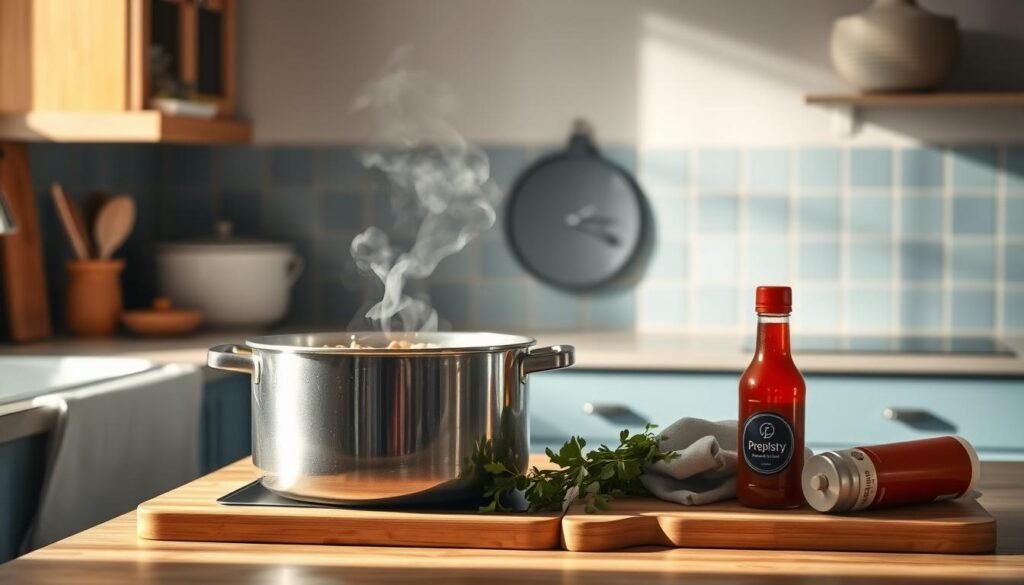
Saving Money Without Compromising Taste
Beans and lentils transform budget meals into nutrient-rich dishes. A single batch of vegetarian chili uses pantry staples like canned tomatoes and dried spices—stretch it further by serving over baked potatoes or mixing with rice. Another thing I love: repurposing roasted chicken carcasses into broth for soups or grain bowls.
“Great flavor doesn’t require expensive ingredients,” I tell clients. “Smoked paprika and cumin turn basic chili into a depth-packed meal that freezes beautifully.”
Try these strategies:
- Buy whole chickens instead of pre-cut parts—roast once, use three ways
- Batch-cook grains on Sundays to reduce daily cooking costs
- Use wilted veggies in frittatas or blended sauces
One family’s “clean-out-the-fridge” stir-fry became their most requested dish. They combined leftover quinoa, roasted sweet potatoes, and a fried egg—proof that creativity beats costly ingredients every time.
Insights from Top Meal Prep Experts and Sources
The best kitchen wisdom often comes wrapped in flour-dusted aprons. I’ve gathered game-changing strategies from culinary pros who’ve mastered the art of efficient cooking.
Proven Strategies for Smart Cooking
Downshiftology’s Lisa Bryan revolutionized my oven use. “Roast vegetables at 425°F while baking chicken below – the dual heat zones save 40% energy,” she advises. Try tossing sweet potatoes in coconut oil before roasting – their caramelized edges elevate grain bowls and breakfast hashes.
Budget Bytes founder Beth Moncel swears by banana-based energy bites. Mash ripe bananas with oats and peanut butter, then freeze. These no-bake wonders satisfy sweet cravings while using up overripe fruit.
“Coconut milk transforms basic grains into tropical delights,” shares Bryan. “Simmer jasmine rice in it for a Thai-inspired base that pairs with shrimp or tofu.”
Three expert-backed techniques:
- Batch-roast vegetables with coconut oil on Sunday for weekday stir-fries
- Use oven residual heat to crisp chickpeas after baking main dishes
- Freeze banana slices for instant smoothie thickeners
| Expert | Signature Technique | Time Saved |
|---|---|---|
| Downshiftology | Layered sheet pan meals | 25 mins/day |
| Budget Bytes | Repurposed leftovers | $18 weekly |
These methods helped a client family reduce takeout orders by 60% last quarter. Their secret? Saturday oven sessions creating coconut-curry roasted veggies and banana-oat muffins for grab-and-go mornings.
Ever found a forgotten container in your fridge that turned into a delicious surprise? That’s the magic of intentional planning meeting seasonal abundance. Our journey through smart strategies shows how aligning with nature’s calendar creates meals that nourish both body and schedule.
Three pillars elevate everyday cooking:
- Batch-prepped bases like roasted veggies adapt to multiple dishes
- Fresh ingredients at peak flavor minimize prep time
- Creative combinations (think feta-stuffed peppers or curried chickpea salad) keep taste buds engaged
Your chickpea salad can morph across seasons—toss with mint and watermelon in summer, roast with squash come fall. Crumble feta into grain bowls or blend into dressings for creamy tang without heavy sauces.
Start small: try one freezer-friendly recipe this week. Did your herbed quinoa work in both wraps and soup? That’s progress. Remember my Thursday kitchen meltdown last February? Salvaging it required grabbing pre-chopped veggies and a jar of spiced yogurt—proof that flexible systems trump perfect plans.
Ready to taste the difference? Grab your calendar and circle next month’s market days. Your future self will thank you when Wednesday’s rainbow chickpea salad appears like clockwork—no thinking required.
Spring Herbed Lentil & Asparagus Lunch Bowls
A vibrant and nourishing bowl featuring tender lentils, crisp asparagus, and fresh herbs, perfect for a light yet satisfying spring meal.
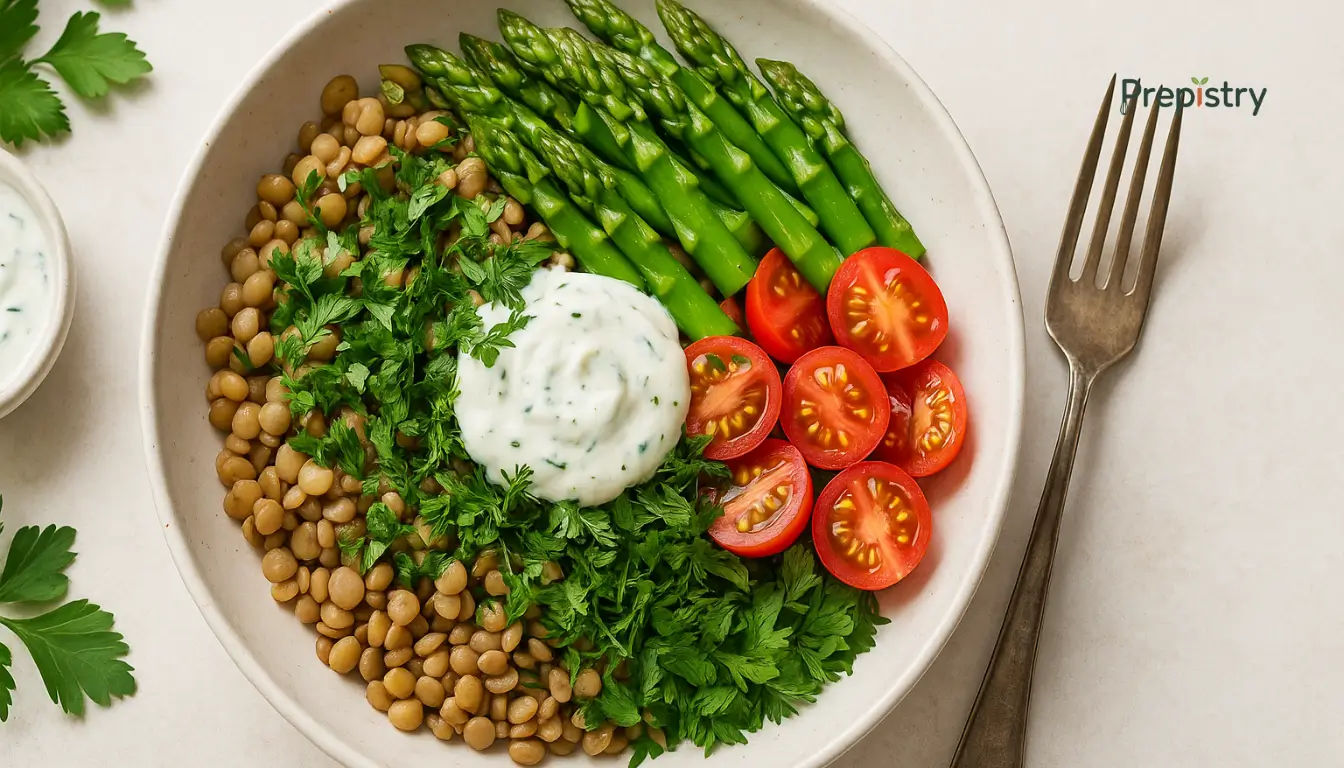
Nutrition Information
Equipment Needed
- Medium saucepan
- Large skillet
- Mixing bowl
- Cutting board
- Knife
Ingredients
-
1 cup green lentils, rinsed
-
2 cups water
-
1 bunch asparagus, trimmed and cut into 2-inch pieces
-
1 tablespoon olive oil
-
1/4 teaspoon salt
-
1/4 teaspoon black pepper
-
1/4 cup chopped fresh parsley
-
2 tablespoons chopped fresh dill
-
1 tablespoon lemon juice
-
1 teaspoon Dijon mustard
-
2 cups mixed greens
-
1 avocado, sliced
-
1/4 cup toasted sunflower seeds
Instructions
Recipe Video
Spring Herbed Lentil & Asparagus Lunch Bowls
Learn how to prepare a fresh and healthy Spring Herbed Lentil & Asparagus Lunch Bowl, perfect for a light meal.

